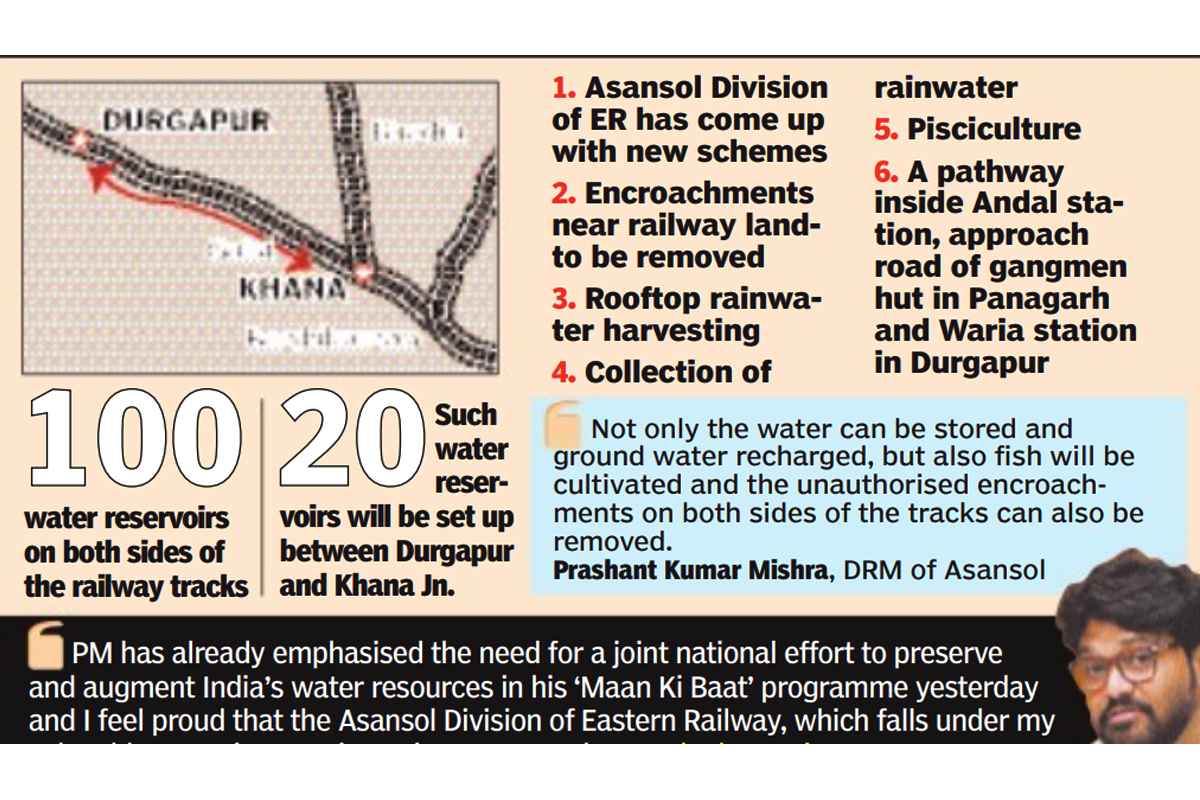Sealdah division revolutionize passenger convenience
Implementation of this QR code-based payment system all over the division brings unyielding security and total transparency for the passengers, thereby boosting Digital India movement.
A pathway inside Andal station, approach road of gangmen hut in Panagarh and Waria station in Durgapur have been set up. The life of these roads are over 50 years. The gaps between the two sleepers are filled up with stone chips.

(Photo: Statesman News Service)
For the first time in the history of railways, the Asansol Division of Eastern Railway has undertaken a strategy to tackle our environmental concerns, generate employment and stop encroachment on both sides of the railway land by setting up over 100 water reservoirs on both the sides of the railway tracks, collect rainwater and start pisciculture.
Mr Prashant Kumar Mishra, divisional railway manager (DRM) of Asansol said that two projects of Asansol division ~ water reservoir of Shatabdi Park and utilisation of unused and released railway sleepers in road construction ~ were highly appreciated by the railway minister Piyush Goyal, in the Annual Environmental Report of Indian Railways tabled in Parliament.
“We are really concerned about the drinking water crisis and in this fiscal we will set up 100 reservoirs of 200 to 400 feet in length and about 15 feet depth. These will be installed around 20 feet away from the track on both sides. Apart from storing the water, the ground water will also be recharged and fish will be cultivated. In this way, all the unauthorised encroachments on both sides of the tracks can be stopped,” he added.
Advertisement
Twenty such water reservoirs will be set up between Durgapur and Khana in West Bengal and even in small stations of Jharkhand like Kalubathan and Chota Ambana, where there is severe water scarcity. Passengers and railway employees will get drinking water in these 20 small stations from these reservoirs. Funds have been released and tenders have also been floated.
“We have already prepared Asansol Water Plan 2050, which includes increase in discharge of water by 20 per cent, reduction in energy consumption by 15 per cent and reduction is transit pipeline by 15 per cent. Rooftop rainwater harvesting has also been undertaken on a big scale. In Asansol and Josidih, two affluent treatment plants will be set up. The purified rain water will be utilised for gardening, platform cleaning, train cleaning and toilet cleaning,” the DRM said.
Rain water harvesting in rooftop has already started at a cost of Rs 24,518 and a total of 150 units will be set up in the entire division. All the nine locations will collect and save 13.4 lakh litres of rain water per annum.
The rainwater harvesting centres are coming up in schools, hospital buildings, railway administrative offices under this division. The water which will be collected through drainpipes from huge surface area in rooftop and stored in reservoirs, will be filtered and then resend for usage.
The low-cost project has already proved how even drain water can become wealth. Dredging and excavation works for reservoirs have already started and once the ponds are filled up with monsoon water, locals will get employment through pisciculture, Mr P K Mishra added.
“Prime Minister Narendra Modi has already emphasised the need for a joint national effort to preserve and augment India’s water resources in his ‘Maan Ki Baat’ programme yesterday and I feel proud that the Asansol Division of railways which falls under my Lok Sabha constituency has been creating instances for the entire country by undertaking unique futuristic projects like rain water harvesting and water reservoirs besides unused railway tracks,” says union minister of state for environment, forests and climate change Babul Supriyo.
In fact, the Asansol Division has also for the first time in India used concrete, used railway sleepers (old and exhausted, rejected railway slippers) for road constructions in Panagarh. The annual rejection of sleepers are about one lakh in a big division like Asansol and every year it becomes an environmental hazard to dump them.
A pathway inside Andal station, approach road of gangmen hut in Panagarh and Waria station in Durgapur have been set up. The life of these roads are over 50 years. The gaps between the two sleepers are filled up with stone chips.
First, the bedis are made up and then the sleepers are put beside one after another. Through the gaps, the rain water passes underground causing no water storages in surface and also recharges ground water level.
In smaller divisions, the amount of released sleepers are over 50,000 per annum and Indian Railways can re-utilise its huge amount of concrete waste (M55 grade concrete slippers) into environment friendly roads.
Advertisement